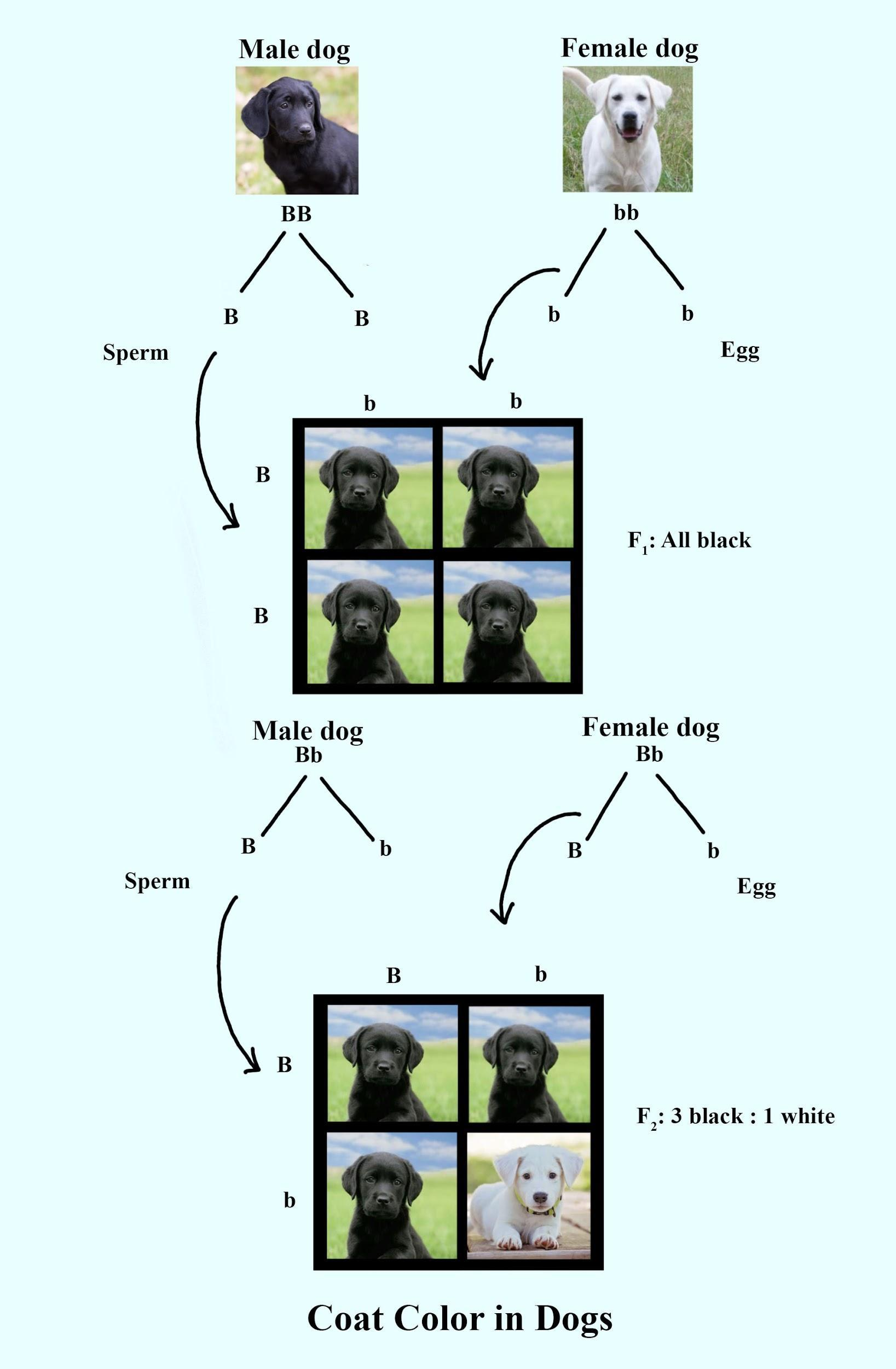
Answer
454.8k+ views
Hint: Dogs have a number of genes that control the color of coats. There are at least 11 gene series (A, B, C, D, E, F, G, M, P, S, and T) known that affect the color of the coat in dogs. A dog inherits from both of its parents one gene. In the phenotype, the dominant gene gets expressed. A dog may be genetically black or brown, for instance, in the B series.
Complete step by step answer:
In dogs, coat color is governed by a range of genes. At least 11 genes that affect the color of a dog's coat have been identified. A dominant gene is a gene found in both homozygous and heterozygous conditions, while a recessive gene is expressed only in homozygous conditions.
Let's consider that homozygous black (BB) is one parent and homozygous brown (bb) is another parent. The offspring with the genetic make- up Bb is formed by a cross between the two parents. We don't know if black is dominant now, or brown is dominant now. We can tell which one is a dominant trait by observing the produced off- springs. If the F1 generation is black, we can say that black is dominant, and if it is brown, we can say that brown is dominant.

- Choose two types of dogs, one with a white coat, the other with a black coat.
- Crossbreed them with one variation of a male dog and the other variation with a female dog.
- Observe the color of the F1 generation's offspring.
- Now, bring about breeding among the F1 generation species.
- Observe the coat color of F2 generation species (pups) and note the differences in coat color.
- Draw conclusions based on your analysis.
The possible inheritance pattern could be:
3:1 phenotypic ratio
Color of the black coat (3): White coat color (1)
Note: Let us presume that homozygous black (BB) is one parent, while homozygous brown (bb) is the other parent. All the offspring are heterozygous (Bb) in this situation.
Since black (B) is dominant, all of the offspring will be black. They may have both B and b alleles, however. If these heterozygous pups are crossed, 25 percent homozygous black (BB), 50 percent heterozygous black (Bb), and 25 percent homozygous brown (bb) offspring will be generated.
Complete step by step answer:
In dogs, coat color is governed by a range of genes. At least 11 genes that affect the color of a dog's coat have been identified. A dominant gene is a gene found in both homozygous and heterozygous conditions, while a recessive gene is expressed only in homozygous conditions.
Let's consider that homozygous black (BB) is one parent and homozygous brown (bb) is another parent. The offspring with the genetic make- up Bb is formed by a cross between the two parents. We don't know if black is dominant now, or brown is dominant now. We can tell which one is a dominant trait by observing the produced off- springs. If the F1 generation is black, we can say that black is dominant, and if it is brown, we can say that brown is dominant.

- Choose two types of dogs, one with a white coat, the other with a black coat.
- Crossbreed them with one variation of a male dog and the other variation with a female dog.
- Observe the color of the F1 generation's offspring.
- Now, bring about breeding among the F1 generation species.
- Observe the coat color of F2 generation species (pups) and note the differences in coat color.
- Draw conclusions based on your analysis.
The possible inheritance pattern could be:
3:1 phenotypic ratio
Color of the black coat (3): White coat color (1)
Note: Let us presume that homozygous black (BB) is one parent, while homozygous brown (bb) is the other parent. All the offspring are heterozygous (Bb) in this situation.
Since black (B) is dominant, all of the offspring will be black. They may have both B and b alleles, however. If these heterozygous pups are crossed, 25 percent homozygous black (BB), 50 percent heterozygous black (Bb), and 25 percent homozygous brown (bb) offspring will be generated.
Recently Updated Pages
10 Examples of Evaporation in Daily Life with Explanations

10 Examples of Diffusion in Everyday Life

1 g of dry green algae absorb 47 times 10 3 moles of class 11 chemistry CBSE

What is the meaning of celestial class 10 social science CBSE

What causes groundwater depletion How can it be re class 10 chemistry CBSE

Under which different types can the following changes class 10 physics CBSE

Trending doubts
Fill the blanks with the suitable prepositions 1 The class 9 english CBSE

Which are the Top 10 Largest Countries of the World?

How do you graph the function fx 4x class 9 maths CBSE

Distinguish between the following Ferrous and nonferrous class 9 social science CBSE

The term ISWM refers to A Integrated Solid Waste Machine class 10 social science CBSE

The Equation xxx + 2 is Satisfied when x is Equal to Class 10 Maths

Difference between Prokaryotic cell and Eukaryotic class 11 biology CBSE

Which is the longest day and shortest night in the class 11 sst CBSE

In a democracy the final decisionmaking power rests class 11 social science CBSE




